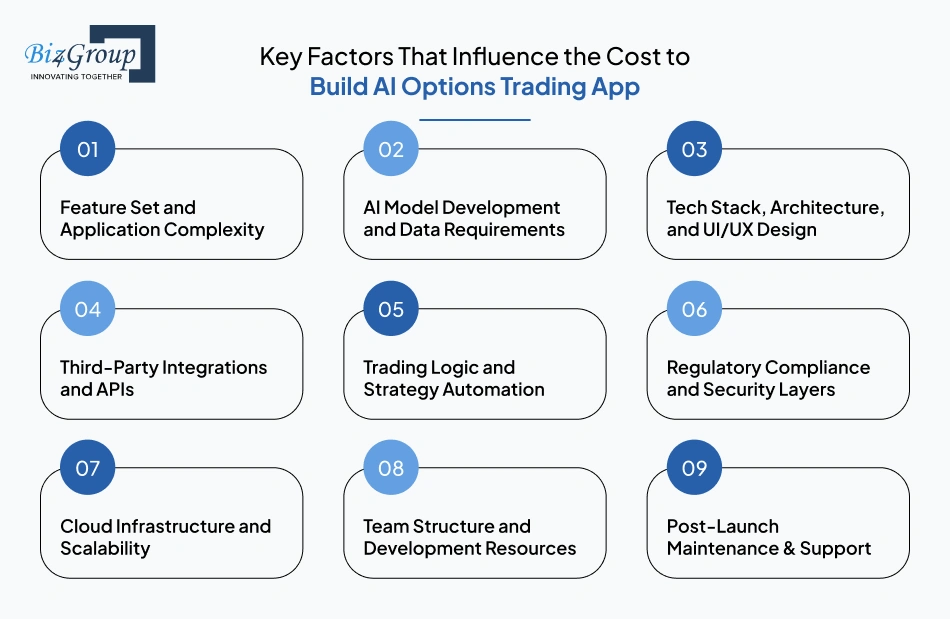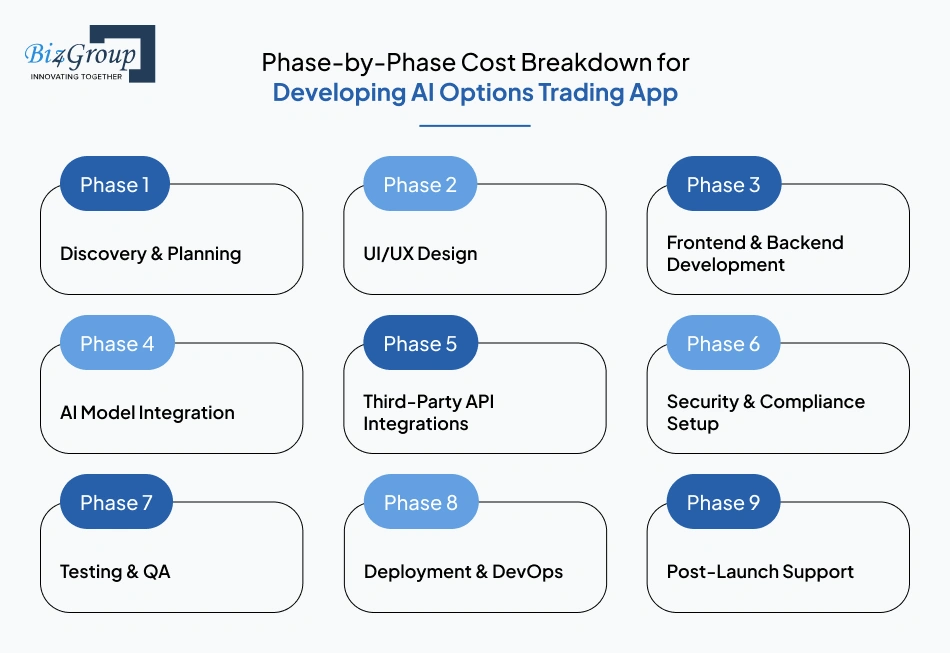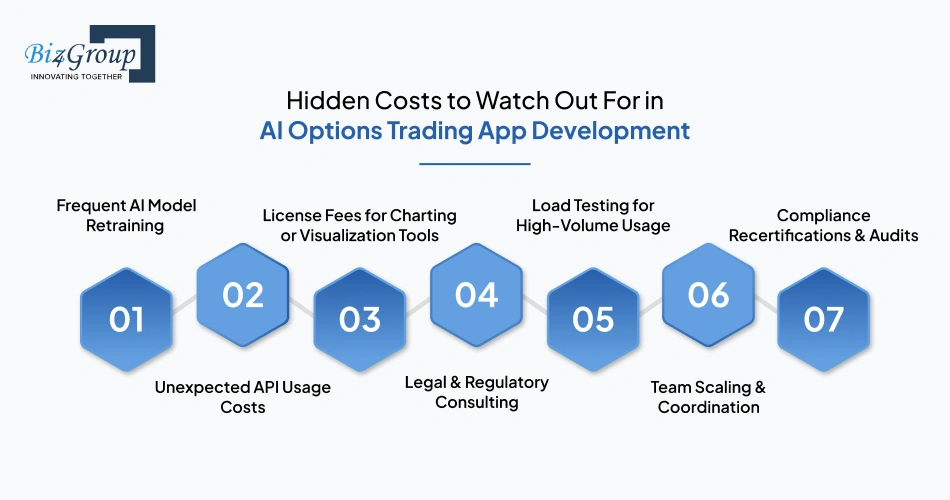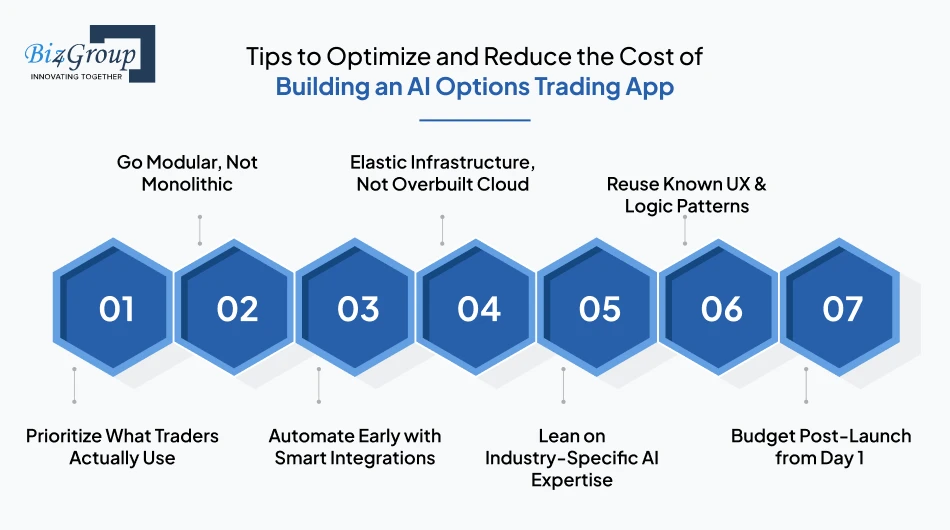Basic AI Chatbot Pricing: A simple chatbot that can answer questions about a product or service might cost around $10,000 to develop.
Read More

Trading options has always been a high-stakes game. Timing, analysis, and strategy can make or break a trade. But today, with the surge of algorithm-driven tools, we're witnessing a seismic shift in how trading desks operate. Human instinct alone no longer cuts it.
That’s where AI options trading apps come in.
AI options trading apps are no longer futuristic experiments. They’ve become strategic assets for firms looking to gain an edge in a market that moves in milliseconds.
Let’s start with a quick reality check:
That explosive growth isn't just about speed; it's about smarter decision-making.
AI options trading apps bring automation, predictive analytics, and real-time data crunching into one place. Whether you're building for internal desk traders or retail investors, these apps can model volatility shifts, process complex options strategies, and make lightning-fast trade decisions using historical data and AI models.
But let’s talk numbers.
What is the cost to develop AI options trading app in 2025?
The cost to develop AI options trading app typically ranges between $80,000 and $250,000 or more, depending on the scope, complexity, and technical requirements involved. That includes everything from integrating live data feeds and AI models to ensuring regulatory compliance and performance optimization.
If you’re planning to invest in such a platform, it's essential to partner with a team that understands both the tech and the trading. That might mean working with a seasoned AI app development company experienced in intelligent model architecture or a trading software development company that can engineer robust execution systems and broker integrations.
Understanding the AI options trading app development cost early helps you avoid missteps, plan efficiently, and build with confidence.
Let’s talk numbers. One of the most searched questions in the fintech space right now is, what is the cost of building AI options trading app in today’s market?
The truth? It depends on how smart, scalable, and sophisticated you want your platform to be.
Here’s how the AI options trading app development cost typically breaks down in 2025:
Estimated cost: $80,000 – $120,000
This level covers the essentials. It’s ideal for early-stage fintech startups testing their product-market fit or firms rolling out internal tools.
You’re looking at:
A solid foundation that leaves room to grow.
Estimated cost: $120,000 – $180,000
A more powerful platform with expanded functionality, deeper analytics, and enhanced user experience.
Key inclusions:
At this level, you’re combining smart tech with polished delivery, exactly what growing fintech platforms aim for.
Estimated cost: $200,000 – $250,000+
This is where you go from impressive to industry-grade. Ideal for firms that want a fully automated, AI-driven solution capable of managing large-scale trading operations.
What’s inside:
This level often includes support from a dedicated AI agent development company to implement real-time automation and model-driven logic aligned with your trading goals.
The building AI options trading app cost at any of these levels depends on scope, team structure, tech stack, and data licensing — all of which we’ll break down next.
If you're planning to go live with features like real-time decision-making, volatility modeling, or smart alerts, you'll also want to consider support from scalable enterprise AI solutions that align with regulatory and performance needs.
It doesn’t have to. Especially when you know where to build smart and where to save smarter.
Talk to Our Experts
Knowing the price range is one thing. Understanding why the price lands where it does? That’s where things get interesting.
Several variables influence the cost to develop AI options trading app, and they go far beyond just picking a tech stack or hiring developers. From the complexity of AI models to the intricacies of regulatory compliance, each decision you make behind the scenes has a direct impact on your budget.
This section breaks down the most critical factors that shape the AI options trading app development cost—so you can prioritize features, avoid bloated estimates, and budget like a pro. Whether you're building a lean MVP or a full-fledged institutional platform, these are the levers that determine how far your money will go.
Features are where your budget starts to bend—or break. Every new capability you want to include comes with its own design, development, integration, and testing costs. And when AI is involved, those costs can stack up fast.
Your AI options trading app development cost is directly tied to what you’re building and how intelligent you want it to be.
Let’s break down the most requested features in trading apps and how each one impacts the overall cost to develop AI options trading app.
Key Features and Their Cost Impact
Pulls in live options data like strike prices, expiration, volume, and bid/ask spreads.
Lets users place or modify trades directly through a linked broker account.
Uses historical data and real-time inputs to suggest high-probability options strategies.
Allows users to construct and simulate multi-leg strategies like iron condors or straddles.
Displays real-time calculations for delta, gamma, theta, and implied volatility.
Simulates how strategies would have performed using historical data.
Forecasts asset price movement, volatility swings, or IV spikes using AI.
Pulls in financial headlines and social sentiment to enhance trade decisions.
Logs every action for auditing, accountability, and SEC/FINRA compliance.
Enables role-based access control for different user types (e.g., admins, traders, analysts).
Sends updates for price changes, volume spikes, or volatility shifts.
|
Feature |
Purpose |
Estimated Cost Impact |
|---|---|---|
|
Real-Time Options Chain Integration |
Live options data access |
$10,000 – $25,000 |
|
Manual Trade Execution |
Place trades through broker APIs |
$8,000 – $20,000 |
|
AI-Driven Trade Recommendations |
Intelligent trade suggestions |
$20,000 – $40,000 |
|
Options Strategy Builder |
Construct complex trading strategies |
$15,000 – $35,000 |
|
Greeks & Risk Visualization |
Monitor delta, gamma, IV in real-time |
$10,000 – $25,000 |
|
Backtesting Engine |
Validate strategies with historical data |
$15,000 – $30,000 |
|
Predictive Analytics |
Forecast asset moves and volatility |
$20,000 – $45,000 |
|
News & Sentiment Integration |
Add contextual insights for trades |
$10,000 – $22,000 |
|
Compliance & Audit Trails |
Ensure traceability and regulatory alignment |
$7,000 – $15,000 |
|
Custom User Roles & Permissions |
Role-based access and segmentation |
$5,000 – $12,000 |
|
Alerts & Real-Time Notifications |
Trigger based on trade, price, or volatility events |
$6,000 – $14,000 |
Understanding your required features upfront helps avoid surprises later. The more advanced your stack, the more planning (and budget) you’ll need — especially when trying to balance innovation with compliance. Each choice directly impacts the cost to build AI options trading app, so every added feature should align with a clear business outcome.
AI is the backbone of intelligence in your platform. Whether it’s powering trade predictions, scanning market patterns, or adapting to volatility in real time, your AI model directly influences how smart and how expensive your app becomes.
So, what is the cost of building AI options trading app when AI plays a central role? It depends on the level of model sophistication, the data quality, and how much of that AI logic needs to be custom-built.
Let’s break it down.
When you’re creating predictive models from scratch, you’re not just writing code. You’re building a decision-making engine trained on massive volumes of historical and real-time data.
These models often include:
If you’re building a fully autonomous AI trading agent, you’ll need not just modeling expertise but also real-time learning and reinforcement mechanisms.
Estimated cost: $25,000 to $60,000+
This is often one of the largest contributors to overall AI options trading app development cost, particularly for enterprise-level platforms.
Some platforms take a leaner approach by using pre-trained models or open-source libraries. These can be adapted to your platform and fine-tuned using your custom data sets.
While cheaper than custom builds, this still requires data cleaning, backend configuration, and validation.
Estimated cost: $10,000 to $30,000
If you're looking to create AI options trading app cost estimate with faster time-to-market, this is often the sweet spot.
You can’t train or operate a smart app without solid data. For AI models to be effective, they need:
Data sources like Nasdaq, IEX Cloud, Polygon, and Tradier provide these feeds—but not for free.
Estimated cost: $5,000 to $25,000 annually
These feeds are critical to real-time inference and learning, and directly impact both accuracy and the cost to develop AI options trading app.
You’ll also need backend architecture to handle ingestion, storage, filtering, and streaming—another cost driver tied closely to your data setup.
If your AI model is the engine, then data is the fuel. Together, they define how capable and how competitive your platform becomes. When it comes to budgeting for AI options trading app development, this category deserves serious attention. And if you’re planning for automation, predictive logic, and deep analysis, it’s where a major chunk of your investment will go.
Understanding these layers up front can lead to a more accurate cost analysis for AI options trading app development and help you avoid under-scoping your AI roadmap.
The technology stack isn’t just about how your trading app runs—it shapes the user experience, scalability, performance, and the long-term cost to build AI options trading app.
Choose a lightweight stack and you’ll get to market quickly, with fewer moving parts. But go for enterprise-grade infrastructure, real-time data handling, and sophisticated frontend frameworks, and your AI options trading app cost goes up fast.
Here’s how different layers of your stack directly influence your budgeting for AI options trading app development.
This is where the brain of your platform lives. These tools allow for training, deployment, and integration of machine learning models.
Handles user authentication, trade execution logic, risk calculations, portfolio management, and real-time data syncing.
This is what your traders actually see and touch. The frontend must be fast, real-time, and crystal clear under pressure.
Where your app—and your AI models—actually live. Infrastructure also impacts performance, uptime, and scale-readiness.
You need instant updates for options chains, trade executions, alerts, and signals. That means streaming data tools and message queues.
If you're planning a cross-platform mobile app, you’ll need mobile frameworks, additional UI components, and responsive logic.
The design of your platform determines how easily traders can react to market shifts. Clunky layouts equal missed trades.
|
Component |
Tools / Platforms |
Estimated Cost Impact |
|---|---|---|
|
AI/ML Frameworks |
TensorFlow, PyTorch, Scikit-learn |
$10,000 – $40,000 |
|
Backend |
$10,000 – $25,000 |
|
|
Frontend |
React, Next.js, Highcharts, TradingView, WebSockets |
$8,000 – $20,000 |
|
Cloud Infrastructure |
AWS, Azure, GCP, Kubernetes, Docker, Prometheus |
$5,000 – $15,000 setup + hosting |
|
Real-Time Messaging |
Kafka, RabbitMQ, Redis Streams |
$6,000 – $15,000 |
|
Mobile Development |
Flutter, React Native, Swift, Kotlin |
$10,000 – $30,000 (if applicable) |
|
UI/UX Design Systems |
Figma, TailwindCSS, Material UI |
$7,000 – $20,000 |
Choosing the right stack is more than a technical decision—it’s a cost strategy. A solid foundation ensures scalability, reduces maintenance, and optimizes performance. And when done right, it can prevent scope creep that derails timelines and bloats your cost to create AI options trading app.
In AI-powered options trading apps, third-party integrations are where convenience meets complexity—and where your budget can start to balloon. These integrations may seem plug-and-play on the surface, but the truth is, every API comes with its own quirks, limitations, compliance requirements, and implementation time.
The more you integrate, the more time it takes to stitch it all together, test it thoroughly, and ensure your platform works seamlessly under pressure.
Let’s break down the types of integrations that can significantly impact the cost to develop AI options trading app.
These enable actual trade execution. Whether you're routing trades through Alpaca, Tradier, Interactive Brokers, or TDAmeritrade, each platform has its own authentication, order handling logic, and latency considerations.
Estimated cost: $10,000 to $30,000 per broker integration
If you're supporting multiple brokers, expect this part of the AI options trading app development cost to grow fast.
Data is the lifeblood of any AI trading app. You’ll need both historical and live feeds to power features like options chains, price alerts, volatility scans, and predictive models.
Popular providers:
Common integrations:
Estimated cost: $5,000 to $25,000+ per year (licensing)
Integration cost: $8,000 to $18,000 depending on number of sources and data granularity
This forms a big chunk of your budgeting for AI options trading app development—especially if you're building analytics-heavy platforms.
For platforms dealing with real money, user verification isn’t optional. You’ll likely need integration with identity verification services or KYC vendors.
Estimated cost: $4,000 to $10,000
Increases your building AI options trading app cost, but ensures compliance and reduces risk.
Most users want real-time alerts via push, SMS, or email. These are enabled using third-party services.
Estimated cost: $3,000 to $8,000
While seemingly minor, they play a big role in user engagement.
Many platforms also integrate with tools for user analytics, trade logs, and admin oversight.
Estimated cost: $5,000 to $12,000
Especially useful in enterprise environments or multi-role access platforms.
Each API needs to be:
And that’s on top of any licensing or monthly subscription fees charged by providers. If your platform relies on live trading, any error in integration becomes a liability—so QA and security here are non-negotiable.
All of this makes integrations a sneaky but powerful driver of the overall cost to build AI options trading app.
Trading logic is the core of how your AI app reacts to market conditions—whether that’s executing trades automatically, adjusting strategies in real time, or offering smart suggestions.
The more complex the logic, the higher your AI options trading app development cost. Apps with simple manual execution require minimal logic, while those with auto-strategy execution, real-time triggers, or risk-based decisions need advanced backend workflows.
Platforms that support dynamic strategy building, like those found in an AI forex trading bot, typically integrate predictive analytics, rules engines, and broker APIs into one automated system.
Estimated cost impact: $20,000 to $50,000+
This depends on the depth of strategy automation, responsiveness, and how tightly it integrates with real-time data.
Factoring this in early helps define how much should you budget to develop an AI options trading app, especially if automation is a core selling point. It’s also a key driver behind the total building AI options trading app cost for most high-performance platforms.
If your app handles live trades, personal data, or financial transactions, compliance isn’t optional—it’s a requirement. Regulatory frameworks like FINRA, SEC, and KYC/AML dictate what must be tracked, stored, and auditable.
Add to that security expectations like data encryption, access controls, activity logs, and real-time alerts, and suddenly your AI options trading app development cost jumps significantly.
Security protocols must be baked into every layer—from user login to trade execution—and the more robust they are, the better your platform’s long-term credibility.
Platforms targeting financial institutions or broker-dealer integrations typically work with a Fintech software solution partner to ensure compliance, audit readiness, and secure infrastructure.
Estimated cost impact: $15,000 to $40,000+
This range varies based on region, user volume, and regulatory complexity.
For any team estimating the cost to build AI options trading app, compliance and security should never be an afterthought. They’re integral to both trust and long-term scalability.
Every AI-powered trading platform needs a foundation that can handle spikes in traffic, real-time market data, and heavy AI computations—without breaking.
Your cloud architecture plays a central role in both performance and how the cost to develop AI options trading app unfolds over time.
Below is a breakdown of key infrastructure components and their impact on the overall AI options trading app development cost:
Startups may keep things lightweight at first, but if you're building for growth, enterprise readiness, or anything near institutional-grade usage, bringing in an experienced AI development company early on can help prevent painful and expensive rework down the road.
Cloud costs add up quickly—and they don’t stop after launch. They’re a critical part of budgeting for AI options trading app development, and they often scale in direct proportion to user growth, data usage, and AI model performance needs.
Behind every powerful trading platform is a team of experts turning market logic into real-world functionality. The structure and size of your team are major contributors to the overall cost to develop AI options trading app.
Whether you're hiring in-house, outsourcing, or using a hybrid approach, the experience level and region of your development team will directly impact the building AI options trading app cost.
Here’s a breakdown of key roles typically involved and their estimated cost impact:
You don’t need all of these full-time, especially if you’re building an MVP or working with an external partner. However, the more complex your app becomes, the more these roles influence timelines and scope.
Understanding your team needs early helps clarify how much should you budget to develop an AI options trading app and can prevent misalignment between vision and execution.
Building your AI trading app is only half the job. Keeping it updated, compliant, and bug-free is what ensures long-term success.
Post-launch maintenance includes:
Just like with any live AI stock trading app, ongoing support is vital to retain users and maintain trust in volatile markets.
Estimated annual cost:
If you’re calculating the full AI options trading app cost, include maintenance in your budget from day one. It’s a core part of your platform’s health, stability, and compliance over time.
Also, for teams working on their price estimate for building AI options trading application, skipping support is one of the most common (and costly) mistakes.
Let’s turn your AI trading app idea into a working product without blowing the bank.
Talk to Our Experts
To build a scalable, high-performance AI trading platform, it’s not just about writing code. There’s strategy, design, compliance, and deployment involved. Each stage carries its own budget implications.
Here’s how the total cost to develop AI options trading app typically breaks down, from discovery to deployment.
This is where business goals meet product strategy. Your team defines features, user journeys, architecture, and regulatory scope. This phase is essential for accurate scoping and avoiding mid-project surprises.
Design dictates usability. Traders demand fast, intuitive dashboards with minimal friction. This stage shapes the app’s front-end look, feel, and behavior.
The core phase where the engine is built. It includes data syncing, trade execution, AI integrations, and user management.
Whether you’re embedding basic logic or predictive analytics, integrating AI adds intelligence and complexity to the platform.
Essential for executing trades, fetching market data, handling KYC, and sending notifications.
SEC, FINRA, and GDPR aren’t buzzwords—they’re dealbreakers if ignored. Compliance adds layers of development and testing.
Before you go live, everything must be tested—AI models, UI flows, order execution, alerts, and more.
Your app moves to production servers. This includes setting up monitoring tools, auto-scaling infrastructure, CI/CD pipelines, and fallback systems.
Once the app is live, the real work begins—fixes, updates, scaling, and user support. Most apps reserve 15–25% of dev budget for support.
|
Phase |
Estimated Cost |
|---|---|
|
Discovery & Planning |
$5,000 – $15,000 |
|
UI/UX Design |
$7,000 – $20,000 |
|
Frontend & Backend Dev |
$40,000 – $100,000 |
|
AI Model Integration |
$20,000 – $50,000+ |
|
Third-Party API Integration |
$15,000 – $35,000 |
|
Security & Compliance |
$10,000 – $30,000 |
|
Testing & QA |
$5,000 – $15,000 |
|
Deployment & DevOps |
$8,000 – $20,000 |
|
Post-Launch Maintenance |
$10,000 – $40,000/year |

Even with a solid roadmap and a clear scope, some expenses have a sneaky way of showing up after the budget’s approved. These hidden costs might not appear on your initial estimate, but they can make or break your timeline, quality, and user experience.
Below are the most common hidden contributors to the AI options trading app development cost, along with what they typically add to the final bill.
Markets evolve fast. Your AI model needs to stay sharp by ingesting new data, adjusting to volatility changes, and refining predictions.
You may integrate third-party data or broker APIs, but many charge based on volume, rate limits, or monthly calls.
Tools like TradingView widgets or Highcharts often carry commercial licensing costs—especially for white-labeling or high-usage tiers.
SEC compliance, financial disclosures, and privacy policies often require expert legal help, especially in multi-region apps.
Simulating thousands of concurrent users, trade events, and data streaming takes time and special tools. Skipping this risks platform crashes under pressure.
You may start to lean, but new features, feedback loops, and user growth often require hiring or contracting additional resources.
Your app might need yearly audits, new licenses, or compliance updates (e.g., GDPR refreshes, FINRA filings).
Even the best-planned apps run into unforeseen line items. Factoring in a 15–20% buffer on top of your price estimate for building AI options trading application is a smart move, especially in the financial tech space where data, regulations, and users evolve constantly.
We help you plan for them and sometimes avoid them altogether.
Talk to Our Experts
Think building a powerful AI trading platform automatically means six figures? Not necessarily. With the right strategy, tools, and technical mindset, it’s possible to reduce your AI options trading app development cost by 25% to 40% — without sacrificing performance or scalability.
Here’s how smart founders and fintech teams are trimming fat without cutting value:
Skip fringe features in v1. Focus only on essential workflows like options scanning, trade execution, and AI-driven alerts. This lean roadmap can save $20,000 to $40,000 from the overall budget.
Choosing modular architecture over a rigid system saves money in the long run by avoiding full rebuilds when scaling.
Why manually handle user onboarding, document parsing, or AI input pipelines? Automate it all. Using AI integration services early helps eliminate weeks of development.
Don’t pay for peak load if you haven’t launched yet. Build elastic infrastructure that grows with usage. Many startups overspend $5,000 – $10,000 upfront on over-architected systems.
Hiring generalists might seem cheaper, but they often require more iterations. Working with fintech-savvy AI teams saves time and compliance issues.
You don’t need to reinvent how traders view a spread order or analyze theta decay. Leverage proven UI/logic components from established designs like grid trading bot development.
Teams that ignore post-launch costs often overspend on urgent fixes. Planning for support, AI model retraining, and feature extensions early helps reduce emergency dev costs by 30%.
|
Area |
Estimated Savings |
|---|---|
|
Feature Prioritization |
$20,000 – $40,000 |
|
Modular Architecture |
$10,000+ |
|
Early Automation/Integration |
$8,000 – $15,000 |
|
Infrastructure Optimization |
$5,000 – $10,000 |
|
AI Domain Expertise |
20% dev time saved |
|
Reusable Design/Logic Patterns |
$5,000 – $12,000 |
|
Post-Launch Planning |
30% fewer support costs |
|
Total Savings Estimate |
$48,000 – $87,000+ |
Even if your original price estimate for building AI options trading application was $200,000+, strategic decisions can bring it closer to $125,000–$150,000 without cutting corners.
Building an AI-driven options trading platform is one thing. Building it right — fast, secure, scalable, and cost-efficient — is what sets Biz4Group apart.
We don’t just code features. We collaborate with your team to reduce the cost to develop AI options trading app without compromising on performance, compliance, or AI capability.
Whether you're starting from scratch or enhancing an existing system, we tailor our approach based on your goals, timeline, and budget — from startup MVPs to enterprise-grade rollouts.
Our experts have deep experience across fintech, data security, and intelligent automation. We’ve helped businesses like yours launch complex, real-time trading platforms that rival solutions like Trading platform like Warrior Trading but with better time-to-market and cost efficiency.
What you get with Biz4Group:
We understand that managing the AI options trading app cost isn’t just about the initial estimate — it’s about future-proofing your investment. Our team will help you define what matters, eliminate what doesn’t, and build an app your users actually want to trade on.
From backend brains to front-end polish, Biz4Group delivers complete, cost-conscious solutions that bring your AI trading vision to life.
We build AI-powered trading apps that don’t come with sticker shock.
Let’s TalkIf there’s one thing you should take away from this guide, it’s the cost to develop AI options trading app depends as much on the how as the what.
From strategic planning and tech stack choices to AI model tuning and cloud deployment, every decision shapes the final number on your invoice. Whether you’re budgeting for a lightweight MVP or a multi-asset powerhouse, understanding the AI options trading app development cost up front puts you in control — not the other way around.
And when you’re ready to turn that budget into a working, scalable, real-world product
That’s where Biz4Group comes in.
As a trusted partner to startups, fintechs, and enterprises, we bring years of experience in building secure, scalable, and cost-optimized AI trading systems. We don’t just deliver code — we deliver results. Our team knows how to balance cutting-edge AI with compliance, usability with speed, and innovation with cost-efficiency.
If you're serious about creating a next-gen trading platform that performs under pressure and grows with your business, Biz4Group is the team you want in your corner.
Let’s build your AI-powered trading platform — the right way, the first time.
The average cost to develop AI options trading app in 2025 ranges from $80,000 to $250,000+, depending on feature set, AI complexity, team structure, and compliance needs. Apps built for high-frequency trading or integrated with custom AI models tend to sit on the higher end of the spectrum.
The biggest cost drivers include AI model integration, real-time trade execution, third-party API integrations (broker, market data, etc.), security and compliance, and scalable cloud infrastructure. These all directly affect the total AI options trading app development cost.
For predictive capabilities (e.g., AI-driven trade suggestions or volatility forecasts), you should budget $150,000 to $250,000+ depending on whether you're building from scratch or integrating pre-trained models. These advanced features significantly increase the AI options app development price due to training, tuning, and infrastructure requirements.
Yes, using pre-built libraries or APIs for KYC, charting, or trade execution can reduce the cost to build AI options trading app by 20–30%. However, balance is key — too many shortcuts can limit scalability and long-term flexibility.
Start with a detailed scope document that covers features, user flows, AI components, and compliance needs. Then, consult with a team experienced in AI options app development price estimates. Accurately creating AI options trading app cost estimate depends on mapping both functionality and risk.
Typically, the building AI options trading app cost is higher than basic stock or crypto bots due to options-specific complexity (greeks, expiration, strategies like straddles/strangles). You'll also need stronger AI logic for volatility forecasting and execution timing.
Absolutely. When scaling to enterprise-grade systems, expect added costs for user role management, audit trails, robust cloud infra, custom AI models, and deeper compliance. This can double your total AI options trading app cost, but it future-proofs the platform and supports larger user bases securely.
with Biz4Group today!
Our website require some cookies to function properly. Read our privacy policy to know more.